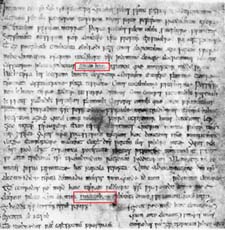'Tuican hom'
First written mention of 'Tuican hom' in a Charter
704

The 704 Charter: Twickenham's earliest surviving documentary record
The first written record of the existence of Twickenham is in a charter of 704 AD where the settlement is described both as Tuican hom and Tuiccanham. The surviving document is probably an early copy of the original charter, made late in the 8th century and now in the British Museum.

Later deeds offer a variety of spellings of the name, and there can be no certainty about its origin. 'Ham' was a Saxon name ending and there is also a Saxon word 'wic' which was derived from a Roman word 'vicus' for a small settlement. Another word 'hamm', is possibly of English origin, meaning variously 'land in a river bend or promontory, dry ground in a marsh, river meadow', which is a likely description of the settlement: Twickenham lies between two rivers, the Thames, and the Crane which used to run through marshy land. It has also been suggested that a personal name 'Twicca' led to the name of the settlement but there is no documentary evidence to support this.
Translation from the original Latin
Translated from the original Latin, it reads:
...I therefore think it necessary at all events to bind (my statement) with ordinary writing in order to give it additional strength. Wherefore I, Swaefred, King of the East Saxons, and I, Paeogthath with the permission of the gracious King Ethelred have determined to give Bishop Waldhere for his lordship a certain portion of land for the salvation of our souls, that is thirty cassati, in the place which is called Tuican hom, in the province which is named Middlesex. Now this land is marked off by the following local boundaries; on the east and south it is terminated by the river Thames, on the north by a flooded plain, the name of which is Fishbourne. And we have over the possessions of this land as above said, with available fields, pastures, meadows, marshes, fishpond, rivers, enclosures and all appertaining to it, for the lordship of the aforementioned Bishop, to be possessed by him in perpetual right and let him have free power to do whatever he will; further that the presentation of this gift might be properly preserved we added witnesses whose names are inserted below...
Written in the year from the Incarnation of our Lord 704 the thirteenth day of the month of June and I Cenred, King of the Mercians have determined to give to Bishop Waldhere for his lordship for the salvation of my soul this land to the place which is called Tuiccanham and gladly with my own hand have appended a cross…
This is followed by eleven other crosses as signatures.
Evidence of standing
It is evident from this document that Twickenham was a cultivated settlement of some age and standing at that time and of established area with defined boundaries. A later document confirms that the description "Fishbourne" indicates the origins of the river Crane. More problematic was the value of Twickenham in relation to the salvation that Bishop Waldhere was in a position to offer. Was this, perhaps, more of a political than a spiritual transaction? Bishop Waldhere was bishop of London, appointed by King Ethelred who retired from the kingship, to a monastery, in that year in favour of his nephew Cenred.
Further reading:
A C B Urwin, SAXON TWICKENHAM, Borough of Twickenham Local History Society, paper no 48, 1981
There is a facsimile copy of the charter, with translation in THE BOOK OF TWICKENHAM, compiled by Arthur Burrell, in the Local Studies Library, London Borough of Richmond upon Thames.





